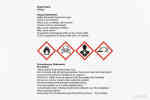Step 3 of 5•11 minutes read
Documentation and Labelling
To keep track of the chemicals onboard, it is required that they all be kept in an inventory, listing the chemicals by their name. Along with this, records of the material safety data sheets (MSDS) should be available to provide insight into the risks and safety precautions available for each chemical. Finally, the products must be labelled in accordance with appropriate rules and guidance to ensure they are easily identified as hazardous.
The Globally Harmonised System Symbols
The Globally Harmonised System Symbols (GHS) is an international standardisation of labeling containers. It was developed to make sure that you, as a consumer, are sure of what possible hazards there are with a certain substance.
Labelling of Hazardous and Dangerous Products
Chemical products that are hazardous to health or the environment must be labeled with danger symbols and a warning text. Important symbols to be aware of include:
Extremely Flammable or Highly Flammable. Liquids with this symbol emit fumes which can ignite or explode when mingled with air. Solids and gases can also carry this symbol. Measures liable to cause a naked flame or sparks may not be taken where flammable goods can ignite.
Oxidising. Oxidising products can react violently/explosively in contact with certain substances.
Material Safety Data Sheets (MSDS)
The supplier of chemical products is obliged to provide a safety data sheet stating the properties of the product from the viewpoint of risks and safety to users. Hazardous properties, such as health dangers or flammability, shall be properly covered. Safety data sheets shall contain all data relevant to the protection of health, safety and the environment under the mandatory headings.

Example for a material safety data sheet including the GHS symbols.
Mandatory Headings in the Material Safety Data Sheets (MSDS)
These 16 headings shall always be included in MSDS documentation, hence easing risk assessment and comparison of products.
-
Identification of the product and of the company.
-
Composition or list of ingredients.
-
Hazard identification.
-
First-aid measures.
-
Fire-fighting measures.
-
Accidental release measures.
-
Handling and storage.
-
Exposure controls and personal protection.
-
Physical and chemical properties.
-
Stability and reactivity.
-
Toxicological information.
-
Ecological information.
-
Disposal considerations.
-
Transport information.
-
Regulatory information.
-
Other information.
Onboard Documentation and Inventory
When a hazardous task needs to be performed, some paperwork must be completed before anyone starts the job. This sort of documentation exists to ensure that the person who performs the task is aware of the possible risks that are included. Examples of this paperwork are risk assessments, and measures to reduce risks – both decided and implemented. Make sure that the following records are documented before you start:
-
A brief description of the task assignment.
-
Identification of hazardous chemical substances.
-
The hazardous properties of each substance.
-
What kind of exposure employees can be subject to?
-
Handling risks coming from the hazardous properties – both when handled as intended and for the occasion that something goes wrong.
-
Taken measures for risk reduction measures, as well as documentation of any decisions not to take measures.
-
Any instructions decided upon.
Append or refer to manufacturer or employer documentation underlying the risk assessment, for example safety data sheets and exposure measurement reports. If it is possible, append the instructions you decided upon to make complying with the requirements easier in the future.